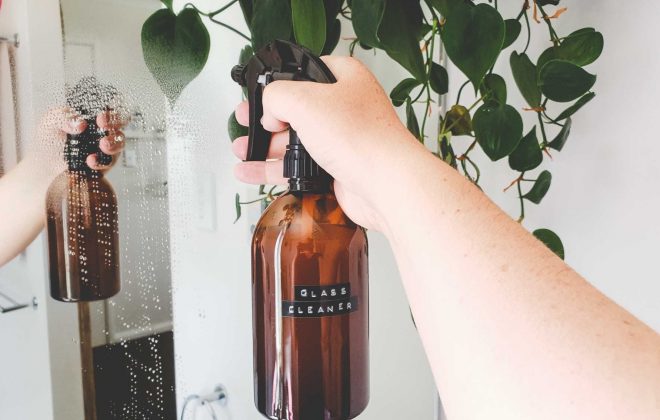10 Toxins to Avoid & Why
Trying to steer clear of toxins can make navigating the shopping isles a stressful experience (especially if the kids are with you!) and the overwhelm can really take over. Avoiding these 10 toxins is a great place to start when creating a greener, safer home for your family.
There are so many Toxic Chemicals
There are shit loads of toxins, you could go on for ever, but that would make the shopping expedition a nightmare! In fact there are roughly 2000 new chemicals introduced each year, so you really would be chasing your tail to try to keep on top of them all! Keeping it simple with just these 10 toxins will get you started and cover most products you buy.
10 Toxins to look out for on Product Labels
If you avoid products containing any of these 10 toxins it will really help simply the process of buying low tox products and protect you from greenwashing.

1. Fragrance
We have listed this first because if this is on the list you don’t need to waste your time looking at any other ingredients.
The term “fragrance” or “parfum” can be used for any number of chemical concoctions, but you can almost guarantee phthalates is one of them. Manufacturers do not need to disclose their fragrance ingredients as they are protected under the guise of “trade secrets” or “proprietary” information. This means they are allowed to group all sorts of toxic chemicals under “Fragrance”.
The International Fragrance Association (IFRA) lists 3,059 chemicals that are reported as being used in fragrance compounds, none of which they need to disclose to you as a consumer. If you want to learn more about the problem with fragrance from here and ways to avoid it click here.
Potential Health Impacts – Cancer, allergies, dermatitis, respiratory distress (including asthma) and can cause potential effects on the reproductive system
Commonly Found In – air fresheners, cleaning products, perfume, cologne, conditioner, shampoo, soap, hand and body wash, moisturisers, washing powders, fabric softeners and even toys!
2. Parabens
Parabens are commonly used preservatives derived from petrochemicals that prevent the growth of bacteria, mould and yeast in cosmetic products and increase shelf life. They are found everywhere, with an estimated 75-90% of cosmetics containing parabens. Parabens are a group of chemicals, so there a number of them that you might find on labels, but they will contain “paraben” in their name, eg isobutyl-, butyl-, isopropyl- and propylparaben.
A big issue with parabens is that they are endocrine disruptors. They mimic estrogen in the body and disrupt the delicate hormonal balance and have been linked to numerous health issues.
Potential Health Impacts – endocrine disruptor, asthma, interferes with gene expression, ADHD, cancer, obesity, type 2 diabetes, Low IQ, neurodevelopment issues, behavioural issues, autism spectrum disorders, premature birth, early puberty, reduced fertility, birth defects, decreased sperm counts and damaged sperm.
Commonly Found In – face cleanser, hand and body wash, body lotion, foundation, shampoo, conditioner, sunscreen, shaving products and toothpastes
3. Phthalates
Phthaltes are a group of chemicals primarily used as “plasticizers”. They make plastics flexible and are also added to products to make fragrances last longer. Phthalates are linked to endocrine disruption, developmental and reproductive toxicity, and cancer, have been banned from cosmetics in the European Union, but still remain in products for sale in Australia.
Potential Health Impacts – endocrine disruptor, asthma, ADHD, cancer, obesity, type 2 diabetes, Low IQ, neurodevelopment issues, behavioural issues, autism spectrum disorders, premature birth, early puberty, reduced fertility, birth defects, decreased sperm counts and damaged sperm.
Commonly Found In – anything containing “fragrance”, deodorant, hair spray, nail polish, body wash , hair care products, soaps & air fresheners.
4. Ethoxolated Ingredients
Ethoxylation is the process of reacting ethylene oxide with other chemicals to make them less harsh. This manufacturing process can result in two toxic contaminants 1,4-Dioxane and ethylene oxide, both of which are carcinogens.
Determining if an ingredient has been ethoxylated can be a tad tricky. Most ingredients that are ethoxylated can be identified by the prefix, word, or syllables “PEG”, “-eth-” (such as laureth, steareth, ceteareth) “polyethylene”, “polyethylene glycol”, “polyoxyethylene” “polysorbate” or “-oxynol-” in their names.
Potential Health Impacts – Immune, liver, kidney, respiratory, neurological and cardiovascular toxicity, Carcinogen. Skin and eye irritation. Mutagen (causes DNA mutation) and teratogen (disturbs the development of an embryo or fetus).
Commonly Found In– laundry detergents, dishwashing liquid, laundry pre-soakers, synthetic resin, rubber adhesives, wood office work surfaces, pharmaceuticals, food products, insecticides & herbicides, paints, varnishes, lacquers stains, paint and varnish removers, shampoo, liquid soap, bubble bath, moisturisers, suncream, serums, gels, foundation, concealer & lip balms
5. Sodium Laurel Sulphate (SLS) / Sodium Laureth Sulphate (SLES)
Sodium Laurel Sulphate (SLS) & Sodium Laureth Sulphate (SLES) can be derived from petroleum or palm oil. These two ingredients often get lumped together as carcinogens, however they are actually quite different chemically. It is actually only SLES that can be contaminated with the carcinogenic compound 1,4-Dioxane, which is a by product of it’s production. Sodium Laurel Sulfate on the other hand is produced by a different process and not contaminated with this carcinogen. However SLS can be an irritant to the skin and cause or aggravate skin conditions.
Potential Health Impacts – SLS – suspected liver toxin, skin and eye irritation, contact dermatitis, rash, hives, eczema, accumulates in organs
SLES – see ethoxylated ingredients
Commonly Found In – toothpaste, shampoo, facial cleaner, foundation, hand & body wash, bubble bath, acne treatments
6. Triclosan
Triclosan is a toxic anti-bacterial that the FDA has deemed no better than soap and water. Still allowed in personal care products in Australia despite being banned in the US. If it provides no advantage over good ‘ol soap and water yet is believed to alter hormone regulation, contribute to the development of antibiotic-resistant germs and be harmful to the immune system and gut microbiome why would you choose to use it.
Potential Health Impacts – skin, eye and lung irritation, asthma, eczema, allergic reactions, hormone disruption, harmful to beneficial microflora
Commonly Found In – soaps, hand and body washes, toothpaste, deodorants.

7. Petroleum Products
Petroleum-based ingredients are derived from crude oil and produced as a by-product of petroleum distillation and may be contaminated with toxins. They have not been assessed for safety in cosmetics and is a suspected carcinogen that accumulates in the body. There is even evidence to suggest that mineral oil hydrocarbons are the greatest contaminant of the human body2.
Petroleum ingredients are cheap filler ingredients that provide no nourishment for your skin at all and actually form a barrier on your skin that prevents it from functioning as it should, no thank you!
Petroleum products can be found on product labels as “petrolatum”, “liquid paraffin”, “paraffin oil”, “mineral oil” etc.
Potential Health Impacts – suspected carcinogen. Liver & respiratory toxicity. Skin and eye irritation. Developmental disruption. Skin Irritation, acne, endocrine disruption.
Commonly Found In – suncream, eye liner, lip balms, baby oil, styling gel, lip gloss, lip stick hair colour, hair serum, eye shadow, concealer, moisturiser
8. Ethanol Amines – MEA/DEA/TEA
Ethanolamines are a group of chemicals derived from petroleum that work as surfactants and emulsifying ingredients in personal care products and cleaning products. When ethanolamines are used in the same product as certain preservatives that break down into nitrogen, nitrosamines can form. Nitrosamines are a class of more than a dozen different chemicals, which the International Agency for Research on Cancer lists individually as possible and known carcinogens.
Common ethanolamines to look out for labels include monoethanolamine (MEA), diethanolamine (DEA) and triethanolamine (TEA).
Potential Health Impacts – Cancer, skin irritation, asthma, suspected neuro, respiratory, immuno, kidney, cardiovascular and liver toxicity
Commonly Found In – Soaps, shampoo, conditioner, hair dye, lotions, shaving creams, paraffin and waxes, household cleaning products, pharmaceuticals, makeup, fragrances, sunscreens, engine degreasers, industrial strength detergents, pesticides, waxes, polishes, laundry liquids
9. Cocamidopropyl Betaine
Cocamidopropyl betaine is a synthetic fatty acid made from coconuts and is used in many products that are considered “natural” for it’s surfactant properties. Cocamidopropyl betaine can cause numerous health effects, which could be due to the ingredient itself or due to impurities, such as 3-dimethylaminopropylamine and is often confused with coco-betaine which is a different chemical.
Because these chemical impurities are amines, they can, under certain conditions, create carcinogenic nitrosamines in a similar manner as MEA/TEA/DEA does above.
Potential Health Impacts – allergic reactions, suspected immunotoxicity, skin irritation, eye irritation, rosacea, eczema and cancer.
Commonly Found In – shampoo, soaps, toothpaste, shaving cream, makeup removers, body washes, detergents, cleaning products, contact lens solutions, disinfecting wipes, hair dyes, bubble baths, facial cleansers.
10. Quaternary Ammonium Compounds
Quaternary ammonium compounds (Quats or QACs) are strong disinfectants and cationic detergent chemicals found in many cleaning products and disinfect wipes and sprays. Quats linger on surfaces long after you have used them, increasing your families exposure every time they come into contact with the surface they were used on.
Quaternary ammonium compounds can cause toxic effects by all routes of exposure including inhalation, ingestion, dermal application and irrigation of body cavities.
Little research has been conducted as to the health effects of quats on humans, however, one study we found shows it can be found in human blood and alterations in inflammatory markers, mitochondrial function, and cholesterol synthesis was observed in a dose-dependent manner. If the other studies conducted on animals translate to humans there are some serious health implications.
Quats also add to the issue in antibiotic-resistant superbugs which is problematic on so so many levels
One of the simplest ways to avoid quats is to not purchase products that advertise as “antibacterial”. If you must buy an antibacterial product check the “active ingredients” and avoid products that contain ingredients that look like this:
- Benzalkonium chloride
- Benzethonium chloride
- Alkyl dimethyl benzyl ammonium chlorides (C12-16)
- Alkyl dimethyl benzyl ammonium chloride (C14 60%, C16 30%, C12 5%, C18 5%)
- Alkyl dimethyl ethylbenzyl ammonium chloride (C12-14)
- Alkyl dimethyl ethylbenzyl ammonium chlorides (C12-18)
- Didecyldimethylammonium chloride
- Dioctyldimethylammonium chloride
Potential Health Impacts – Skin and respiratory irritation, asthma, dermatitis, reproductive system damage and infertility, birth defects, altered immune function, inflammation, disrupt mitochondrial function, endocrine disruption, and inhibited cholesterol synthesis
Commonly Found In – cleaning products, antibacterial wipes and sprays, fabric softeners, dryer sheets, disinfectants, facial cleansers, eye drops, make-up, baby shampoo, baby soap, toothpaste, mouth wash, nasal spray, throat losenges, dish liquids, hand soaps, air fresheners, spa and spool chemicals
All these ingredients & side effects are super scary!
If you’re looking at this list and thinking “But shit!! That’s practically every product out there” you wouldn’t be far off. But trust us when we say you can find products without them or even make them yourself.
You now have the knowledge and the power to start making better choices at the supermarket.
A little bit of information and a definitive list can go a long way to simplifying your toxin removal process. You have that now with this list, you now have the power to make better choices for your family.
How you use this information is up to you. How quickly or slowly you implement the changes in your home is in your hands. At Blooming Mandala we have a ‘collect all the toxic shit and throw it away and start again’ person (Jenny). And we have a ‘as I run out I will replace it with better choices’ person (Jane). There is no right or wrong way, you do what feels right and works for your family.
W can’t wait till you see the positive health impacts even the small changes you implement will make to your family.
We have a kick-ass collection of natural DIY cleaning recipes to help you kick toxins to the curb and save money!
Or maybe you are looking for awesome DIY Personal Care and Beauty Recipes To Nourish Your Body Naturally…
References
- https://www.ewg.org/skindeep/2004/06/15/exposures-add-up-survey-results/
- Journal of Womens Health. (2011). Evidence for cosmetics as a source of mineral oil contamination in women.Scorecard Good Guide.
- The Pollution Information Site (accessed July 2019)
- Agency for Toxic Substances and Diseases Registry(accessed July 2019)
- EWGs Skin Deep Cosmetic Database(accessed July 2019)
- The Chemical Maze Application
- https://www.safecosmetics.org/get-the-facts/chemicals-of-concern/fragrance/ (accessed May 2021)
- https://www.safecosmetics.org/get-the-facts/chemicals-of-concern/ethanolamine-compounds/ (accessed May 2021)
- https://cen.acs.org/safety/consumer-safety/know-enough-safety-quat-disinfectants/98/i30 (accessed May 2021)
- https://www.medrxiv.org/content/10.1101/2020.07.15.20154963v1.full.pdf (accessed May 2021)
- http://www.inchem.org/documents/pims/chemical/pimg022.htm (accessed May 2021)





